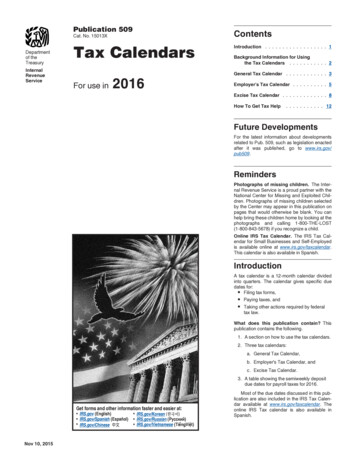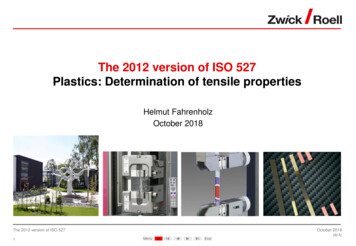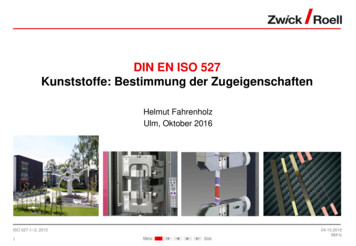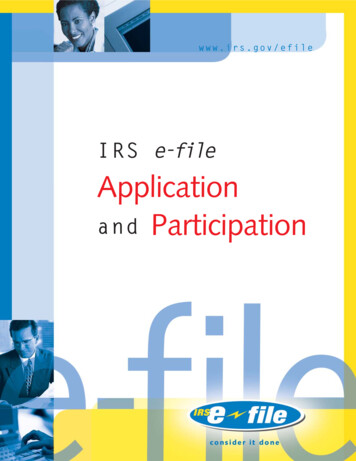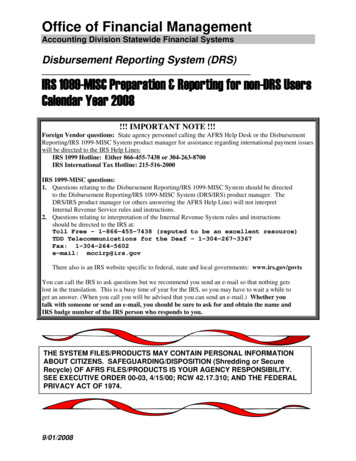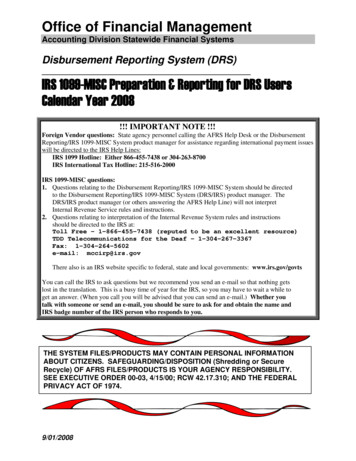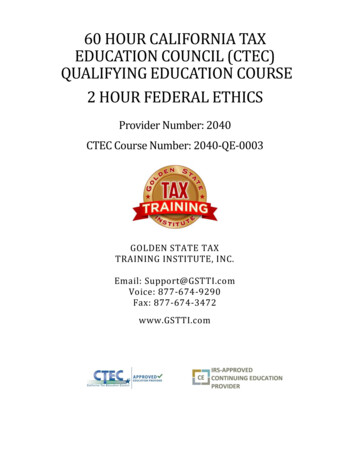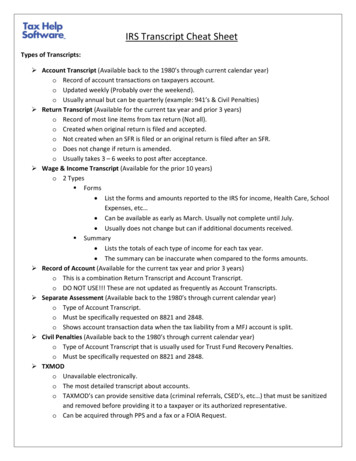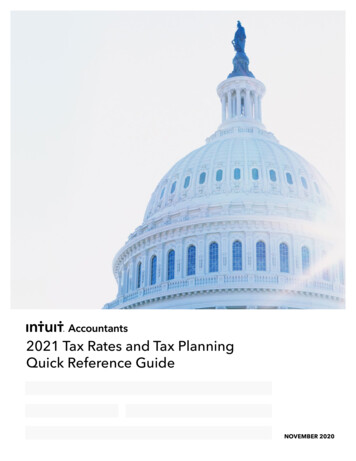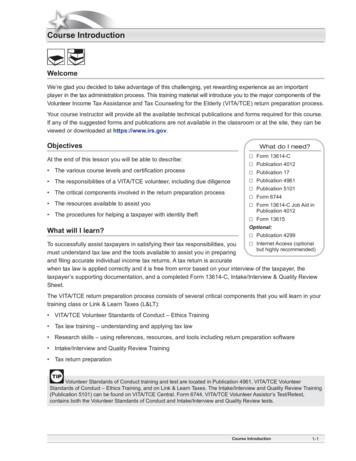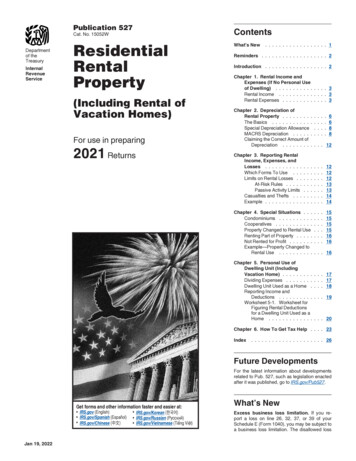
Transcription
Publication 527ContentsResidentialRentalPropertyWhat’s NewCat. No. 15052WDepartmentof theTreasuryInternalRevenueService(Including Rental ofVacation Homes)For use in preparing2021 Returns. 1Reminders . . . . . . . . . . . . . . . . . . . 2Introduction . . . . . . . . . . . . . . . . . . 2Chapter 1. Rental Income andExpenses (If No Personal Useof Dwelling) . . . . . . . . . . . . . . . 3Rental Income . . . . . . . . . . . . . . 3Rental Expenses . . . . . . . . . . . . . 3Chapter 2. Depreciation ofRental Property . . . . . . . .The Basics . . . . . . . . . . .Special Depreciation AllowanceMACRS Depreciation . . . . .Claiming the Correct Amount ofDepreciation . . . . . . . .Chapter 3. Reporting RentalIncome, Expenses, andLosses . . . . . . . . . . .Which Forms To Use . . .Limits on Rental Losses . .At-Risk Rules . . . . .Passive Activity LimitsCasualties and Thefts . . .Example . . . . . . . . . . .6688. . . . 12.12121213131414Chapter 4. Special Situations . . .Condominiums . . . . . . . . . .Cooperatives . . . . . . . . . . .Property Changed to Rental UseRenting Part of Property . . . . .Not Rented for Profit . . . . . . .Example—Property Changed toRental Use . . . . . . . . . .151515151616Chapter 5. Personal Use ofDwelling Unit (IncludingVacation Home) . . . . . . . . .Dividing Expenses . . . . . . . .Dwelling Unit Used as a Home .Reporting Income andDeductions . . . . . . . . . .Worksheet 5-1. Worksheet forFiguring Rental Deductionsfor a Dwelling Unit Used as aHome . . . . . . . . . . . . . . . 16. . . 17. . . 17. . . 18. . . 19. . . 20Chapter 6. How To Get Tax Help . . . . 23Index. . . . . . . . . . . . . . . . . . . . . 26Future DevelopmentsFor the latest information about developmentsrelated to Pub. 527, such as legislation enactedafter it was published, go to IRS.gov/Pub527.Get forms and other information faster and easier at: IRS.gov (English) IRS.gov/Spanish (Español) IRS.gov/Chinese (中文)Jan 19, 2022 IRS.gov/Korean (한국어) IRS.gov/Russian (Pусский) IRS.gov/Vietnamese (Tiếng Việt)What’s NewExcess business loss limitation. If you report a loss on line 26, 32, 37, or 39 of yourSchedule E (Form 1040), you may be subject toa business loss limitation. The disallowed loss
resulting from the limitation will not be reflectedon line 26, 32, 37, or 39 of your Schedule E. Instead, use Form 461 to determine the amountof your excess business loss, which will be included as income on Schedule 1 (Form 1040),line 8o. Any disallowed loss resulting from thislimitation will be treated as a net operating lossthat must be carried forward and deducted in asubsequent year.See Form 461 and its instructions for detailson the excess business loss limitation.Section 179 deduction dollar limits. For taxyears beginning in 2021, the maximum section179 expense deduction is 1,050,000. This limitis reduced by the amount by which the cost ofsection 179 property placed in service duringthe tax year exceeds 2,620,000.Accelerated depreciation for qualified Indian reservation property. The acceleratedrecovery period for qualified Indian reservationproperty will not apply to property placed inservice after December 31, 2021.Credits for self-employed persons. Refundable credits are available to certain self-employed persons impacted by the coronavirus.See the Instructions for Form 7202, Credits forSick Leave and Family Leave for CertainSelf-Employed Individuals, for more information.Paycheck Protection Program (PPP) safeharbor. Revenue Procedure 2021-20 has allowed for a safe harbor for certain taxpayerswho did not deduct certain otherwise deductibleexpenses paid or incurred during the tax year(s)ending after March 26, 2020, and on or beforeDecember 31, 2020, that resulted in, or wereexpected to result in, forgiveness of the loan. Tofind more information, including requirements,of this safe harbor, see IRS.gov/irb/2021-19 IRB#REV-PROC-2021-20.The COVID-19 related credit for qualifiedsick and family leave wages. The FamiliesFirst Coronavirus Response Act (FFCRA) wasamended by recent legislation. The FFCRA requirement that employers provide paid sick andfamily leave for reasons related to COVID-19(the employer mandate) expired on December31, 2020; however, the COVID-related Tax Relief Act of 2020 extends the periods for whichemployers providing leave that otherwise meetsthe requirements of the FFCRA may continue toclaim tax credits for qualified sick and familyleave wages paid for leave taken before April 1,2021.The American Rescue Plan Act of 2021 (theARP) adds new sections 3131 and 3132 to theInternal Revenue Code to provide credits forqualified sick and family leave wages similar tothe credits that were previously enacted underthe FFCRA and amended and extended by theCOVID-related Tax Relief Act of 2020. Thecredits under section 3131 and 3132 are available for qualified leave wages paid for leavetaken after March 31, 2021, and before October1, 2021.RemindersNet Investment Income Tax (NIIT). You maybe subject to the NIIT. NIIT is a 3.8% tax on thelesser of net investment income or the excessPage 2of modified adjusted gross income (MAGI) overthe threshold amount. Net investment incomemay include rental income and other incomefrom passive activities. Use Form 8960 to figurethis tax. For more information on NIIT, go toIRS.gov/NIIT.Self-employed tax payments deferred from2020. If you elected to defer self-employed taxpayments from 2020, see How self-employedindividuals and household employers repaydeferred Social Security tax for more information about due date(s) and payment options.Photographs of missing children. The Internal Revenue Service is a proud partner with theNational Center for Missing & ExploitedChildren (NCMEC). Photographs of missingchildren selected by the Center may appear inthis publication on pages that would otherwisebe blank. You can help bring these childrenhome by looking at the photographs and calling1-800-THE-LOST (1-800-843-5678) if you recognize a child.IntroductionDo you own a second house that you rent outall the time? Do you own a vacation home thatyou rent out when you or your family isn't usingit?These are two common types of residentialrental activities discussed in this publication. Inmost cases, all rental income must be reportedon your tax return, but there are differences inthe expenses you are allowed to deduct and inthe way the rental activity is reported on your return.Chapter 1 discusses rental-for-profit activityin which there is no personal use of the property. It examines some common types of rentalincome and when each is reported, as well assome common types of expenses and whichare deductible.Chapter 2 discusses depreciation as it applies to your rental real estate activity—whatproperty can be depreciated and how much itcan be depreciated.Chapter 3 covers the reporting of your rentalincome and deductions, including casualtiesand thefts, limitations on losses, and claimingthe correct amount of depreciation.Chapter 4 discusses special rental situations. These include condominiums, cooperatives, property changed to rental use, rentingonly part of your property, and a not-for-profitrental activity.Chapter 5 discusses the rules for rental income and expenses when there is also personal use of the dwelling unit, such as a vacation home.Finally, chapter 6 explains how to get taxhelp from the IRS.Sale or exchange of rental property. For information on how to figure and report any gainor loss from the sale, exchange, or other disposition of your rental property, see Pub. 544.Sale of main home used as rental property. For information on how to figure and report any gain or loss from the sale or other disposition of your main home that you also usedas rental property, see Pub. 523.you meet certain qualifying use standards, youmay qualify for a tax-free exchange (a like-kindor section 1031 exchange) of one piece ofrental property you own for a similar piece ofrental property, even if you have used the rentalproperty for personal purposes.For information on the qualifying use standards, see Revenue Procedure 2008-16,2008-10 I.R.B. 547, available at IRS.gov/irb/2008-10 IRB#RP-2008-16. For more information on like-kind exchanges, see chapter 1 ofPub. 544.Comments and suggestions. We welcomeyour comments about this publication and suggestions for future editions.You can send us comments throughIRS.gov/FormComments. Or, you can write tothe Internal Revenue Service, Tax Forms andPublications, 1111 Constitution Ave. NW,IR-6526, Washington, DC 20224.Although we can’t respond individually toeach comment received, we do appreciate yourfeedback and will consider your comments andsuggestions as we revise our tax forms, instructions, and publications. Don’t send tax questions, tax returns, or payments to the above address.Getting answers to your tax questions.If you have a tax question not answered by thispublication or the How To Get Tax Help sectionat the end of this publication, go to the IRS Interactive Tax Assistant page at IRS.gov/Help/ITA where you can find topics by using thesearch feature or viewing the categories listed.Getting tax forms, instructions, and publications. Go to IRS.gov/Forms to downloadcurrent and prior-year forms, instructions, andpublications.Ordering tax forms, instructions, andpublications. Go to IRS.gov/OrderForms toorder current forms, instructions, and publications; call 800-829-3676 to order prior-yearforms and instructions. The IRS will processyour order for forms and publications as soonas possible. Don’t resubmit requests you’ve already sent us. You can get forms and publications faster online.Useful ItemsYou may want to see:Publication463 Travel, Gift, and Car Expenses463523 Selling Your Home523534 Depreciating Property Placed inService Before 1987534535 Business Expenses535544 Sales and Other Dispositions ofAssets544547 Casualties, Disasters, and Thefts547551 Basis of Assets551925 Passive Activity and At-Risk Rules925Tax-free exchange of rental property occasionally used for personal purposes. If946 How To Depreciate Property946Publication 527 (2021)
Form (and Instructions)461 Excess Business Loss Limitation4614562 Depreciation and Amortization45625213 Election To Postpone Determinationas To Whether the PresumptionApplies That an Activity Is Engagedin for ProfitAccrual method. If you are an accrual basistaxpayer, you generally report income whenyou earn it, rather than when you receive it. Yougenerally deduct your expenses when you incurthem, rather than when you pay them.52138582 Passive Activity Loss LimitationsMore information. See Pub. 538, AccountingPeriods and Methods, for more informationabout when you constructively receive incomeand accrual methods of accounting.8960 Net Investment IncomeTax—Individuals, Estates, and TrustsTypes of Income85828960Schedule E (Form 1040) SupplementalIncome and LossSchedule E (Form 1040)1.Rental Incomeand Expenses (IfNo Personal Useof Dwelling)This chapter discusses the various types ofrental income and expenses for a residentialrental activity with no personal use of the dwelling. Generally, each year, you will report all income and deduct all out-of-pocket expenses infull. The deduction to recover the cost of yourrental property—depreciation—is taken over aprescribed number of years, and is discussed inchapter 2.If your rental income is from propertyyou also use personally or rent toCAUTION someone at less than a fair rental price,first read chapter 5.!Rental IncomeIn most cases, you must include in your grossincome all amounts you receive as rent. Rentalincome is any payment you receive for the useor occupation of property. It isn’t limited toamounts you receive as normal rental payments.When To ReportWhen you report rental income on your tax return generally depends on whether you are acash or an accrual basis taxpayer. Most individual taxpayers use the cash method.Cash method. You are a cash basis taxpayerif you report income on your return in the yearyou actually or constructively receive it, regardless of when it was earned. You constructivelyreceive income when it is made available toyou, for example, by being credited to yourbank account.The following are common types of rental income.Advance rent. Advance rent is any amountyou receive before the period that it covers. Include advance rent in your rental income in theyear you receive it regardless of the period covered or the method of accounting you use.Example. On March 18, 2021, you signeda 10-year lease to rent your property. During2021, you received 9,600 for the first year'srent and 9,600 as rent for the last year of thelease. You must include 19,200 in your rentalincome in 2021.Canceling a lease. If your tenant pays you tocancel a lease, the amount you receive is rent.Include the payment in your rental income in theyear you receive it regardless of your method ofaccounting.Expenses paid by tenant. If your tenant paysany of your expenses, those payments arerental income. Because you must include thisamount in income, you can also deduct the expenses if they are deductible rental expenses.For more information, see Rental Expenses,later.Example 1. Your tenant pays the water andsewage bill for your rental property and deductsthe amount from the normal rent payment. Under the terms of the lease, your tenant doesn’thave to pay this bill. Include the utility bill paidby the tenant and any amount received as arent payment in your rental income. You can deduct the utility payment made by your tenant asa rental expense.Example 2. While you are out of town, thefurnace in your rental property stops working.Your tenant pays for the necessary repairs anddeducts the repair bill from the rent payment. Include the repair bill paid by the tenant and anyamount received as a rent payment in yourrental income. You can deduct the repair payment made by your tenant as a rental expense.Property or services. If you receive propertyor services as rent, instead of money, includethe fair market value of the property or servicesin your rental income.If the services are provided at an agreedupon or specified price, that price is the fairmarket value unless there is evidence to thecontrary.Include in your rental income the amount thetenant would have paid for 2 months rent. Youcan deduct that same amount as a rental expense for painting your property.Security deposits. Don’t include a securitydeposit in your income when you receive it ifyou plan to return it to your tenant at the end ofthe lease. But if you keep part or all of the security deposit during any year because yourtenant doesn’t live up to the terms of the lease,include the amount you keep in your income inthat year.If an amount called a security deposit is tobe used as a final payment of rent, it is advancerent. Include it in your income when you receiveit.Other Sources of Rental IncomeLease with option to buy. If the rental agreement gives your tenant the right to buy yourrental property, the payments you receive underthe agreement are generally rental income. Ifyour tenant exercises the right to buy the property, the payments you receive for the period after the date of sale are considered part of theselling price.Part interest. If you own a part interest inrental property, you must report your part of therental income from the property.Rental of property also used as your home.If you rent property that you also use as yourhome and you rent it less than 15 days duringthe tax year, don’t include the rent you receivein your income. Also, expenses from this activity are not considered rental expenses. Formore information, see Used as a home but rented less than 15 days under Reporting Incomeand Deductions in chapter 5.Rental ExpensesIn most cases, the expenses of renting yourproperty, such as maintenance, insurance,taxes, and interest, can be deducted from yourrental income.Personal use of rental property. If yousometimes use your rental property for personalpurposes, you must divide your expenses between rental and personal use. Also, your rentalexpense deductions may be limited. See chapter 5.Part interest. If you own a part interest inrental property, you can deduct expenses youpaid according to your percentage of ownership.Example. Roger owns a one-half undividedinterest in a rental house. Last year, he paid 968 for necessary repairs on the property.Roger can deduct 484 (50% 968) as arental expense. He is entitled to reimbursementfor the remaining half from the co-owner.Example. Your tenant is a house painter.He offers to paint your rental property instead ofpaying 2 months rent. You accept his offer.Chapter 1Rental Income and Expenses (If No Personal Use of Dwelling)Page 3
When To DeductYou generally deduct your rental expenses inthe year you pay them.If you use the accrual method, see Pub. 538for more information.Types of ExpensesListed below are the most common rental expenses. Advertising. Auto and travel expenses. Cleaning and maintenance. Commissions. Depreciation. Insurance. Interest (other). Legal and other professional fees. Local transportation expenses. Management fees. Mortgage interest paid to banks, etc. Points. Rental payments. Repairs. Taxes. Utilities.Some of these expenses, as well as other lesscommon ones, are discussed below.Depreciation. Depreciation is a capital expense. It is the mechanism for recovering yourcost in an income-producing property and mustbe taken over the expected life of the property.You can begin to depreciate rental propertywhen it is ready and available for rent. SeePlaced in Service under When Does Depreciation Begin and End? in chapter 2.Insurance premiums paid in advance. If youpay an insurance premium for more than 1 yearin advance, you can’t deduct the total premiumin the year you pay it. For each year of coverage, you can deduct only the part of the premium payment that applies to that year. Seechapter 6 of Pub. 535 for information on deductible premiums.Interest expense. You can deduct mortgageinterest you pay on your rental property. Whenyou refinance a rental property for more thanthe previous outstanding balance, the portion ofthe interest allocable to loan proceeds not related to rental use generally can’t be deducted asa rental expense. Chapter 4 of Pub. 535 explains mortgage interest in detail.Expenses paid to obtain a mortgage.Certain expenses you pay to obtain a mortgageon your rental property can’t be deducted as interest. These expenses, which include mortgage commissions, abstract fees, and recording fees, are capital expenses that are part ofyour basis in the property.Form 1098, Mortgage Interest Statement. If you paid 600 or more of mortgage interest on your rental property to any one person, you should receive a Form 1098 or similarstatement showing the interest you paid for theyear. If you and at least one other person (otherthan your spouse if you file a joint return) wereliable for, and paid interest on, the mortgage,Page 4Chapter 1and the other person received the Form 1098,report your share of the interest on Schedule E(Form 1040), line 13. Attach a statement to yourreturn showing the name and address of theother person. On the dotted line next to line 13,enter “See attached.”Legal and other professional fees. You candeduct, as a rental expense, legal and otherprofessional expenses such as tax return preparation fees you paid to prepare Schedule E,Part I. For example, on your 2021 Schedule E,you can deduct fees paid in 2021 to preparePart I of your 2020 Schedule E. You can alsodeduct, as a rental expense, any expense(other than federal taxes and penalties) youpaid to resolve a tax underpayment related toyour rental activities.Local benefit taxes. In most cases, you can’tdeduct charges for local benefits that increasethe value of your property, such as charges forputting in streets, sidewalks, or water andsewer systems. These charges are nondepreciable capital expenditures and must be added tothe basis of your property. However, you candeduct local benefit taxes that are for maintaining, repairing, or paying interest charges for thebenefits.Local transportation expenses. You may beable to deduct your ordinary and necessary local transportation expenses if you incur them tocollect rental income or to manage, conserve,or maintain your rental property. However,transportation expenses incurred to travel between your home and a rental property generally constitute nondeductible commuting costsunless you use your home as your principalplace of business. See Pub. 587, Business Useof Your Home, for information on determining ifyour home office qualifies as a principal place ofbusiness.Generally, if you use your personal car,pickup truck, or light van for rental activities, youcan deduct the expenses using one of twomethods: actual expenses or the standard mileage rate. For 2021, the standard mileage ratefor business use is 56 cents a mile. For more information, see chapter 4 of Pub. 463.To deduct car expenses under eithermethod, you must keep records thatRECORDS follow the rules in chapter 5 of Pub.463. In addition, you must complete Form 4562,Part V, and attach it to your tax return.Pre-rental expenses. You can deduct your ordinary and necessary expenses for managing,conserving, or maintaining rental property fromthe time you make it available for rent.Rental of equipment. You can deduct the rentyou pay for equipment that you use for rentalpurposes. However, in some cases, lease contracts are actually purchase contracts. If so, youcan’t deduct these payments. You can recoverthe cost of purchased equipment through depreciation.Rental of property. You can deduct the rentyou pay for property that you use for rental purposes. If you buy a leasehold for rental purpo-Rental Income and Expenses (If No Personal Use of Dwelling)ses, you can deduct an equal part of the costeach year over the term of the lease.Travel expenses. You can deduct the ordinary and necessary expenses of traveling awayfrom home if the primary purpose of the trip is tocollect rental income or to manage, conserve,or maintain your rental property. You must properly allocate your expenses between rental andnonrental activities. You can’t deduct the cost oftraveling away from home if the primary purpose of the trip is to improve the property. Thecost of improvements is recovered by takingdepreciation. For information on travel expenses, see chapter 1 of Pub. 463.RECORDSTo deduct travel expenses, you mustkeep records that follow the rules inchapter 5 of Pub. 463.Uncollected rent. If you are a cash basis taxpayer, don’t deduct uncollected rent. Becauseyou haven’t included it in your income, it’s notdeductible.If you use an accrual method, report incomewhen you earn it. If you are unable to collect therent, you may be able to deduct it as a businessbad debt. See chapter 10 of Pub. 535 for moreinformation about business bad debts.Vacant rental property. If you hold propertyfor rental purposes, you may be able to deductyour ordinary and necessary expenses (including depreciation) for managing, conserving, ormaintaining the property while the property isvacant. However, you can’t deduct any loss ofrental income for the period the property is vacant.Vacant while listed for sale. If you sellproperty you held for rental purposes, you candeduct the ordinary and necessary expensesfor managing, conserving, or maintaining theproperty until it is sold. If the property isn’t heldout and available for rent while listed for sale,the expenses aren’t deductible rental expenses.PointsThe term “points” is often used to describesome of the charges paid, or treated as paid, bya borrower to take out a loan or a mortgage.These charges are also called loan originationfees, maximum loan charges, or premiumcharges. Any of these charges (points) that aresolely for the use of money are interest. Because points are prepaid interest, you generallycan’t deduct the full amount in the year paid, butmust deduct the interest over the term of theloan.The method used to figure the amount ofpoints you can deduct each year follows theoriginal issue discount (OID) rules. In this case,points are equivalent to OID, which is the difference between: The amount borrowed (redemption price atmaturity, or principal); and The proceeds (issue price).The first step is to determine whether yourtotal OID (which you may have on bonds orother investments in addition to the mortgageloan), including the OID resulting from the
points, is insignificant or de minimis. If the OIDisn’t de minimis, you must use the constant-yield method to figure how much you candeduct.De minimis OID. The OID is de minimis if it isless than one-fourth of 1% (0.0025) of the stated redemption price at maturity (principalamount of the loan) multiplied by the number offull years from the date of original issue to maturity (term of the loan).If the OID is de minimis, you can choose oneof the following ways to figure the amount ofpoints you can deduct each year. On a constant-yield basis over the term ofthe loan. On a straight line basis over the term of theloan. In proportion to stated interest payments. In its entirety at maturity of the loan.You make this choice by deducting the OID(points) in a manner consistent with the methodchosen on your timely filed tax return for the taxyear in which the loan is issued.Example. Carol took out a 100,000 mortgage loan on January 1, 2021, to buy a houseshe will use as a rental during 2021. The loan isto be repaid over 30 years. During 2021, Carolpaid 10,000 of mortgage interest (stated interest) to the lender. When the loan was made,she paid 1,500 in points to the lender. Thepoints reduced the principal amount of the loanfrom 100,000 to 98,500, resulting in 1,500of OID. Carol determines that the points (OID)she paid are de minimis based on the followingcomputation.Redemption price at maturity (principalamount of the loan) . . . . . . . . . . . . . . .Multiplied by: The term of theloan in complete years . . . . . . . . . . . .Multiplied by . . . . . . . . . . . . . . . . . . . . .De minimis amount . . . . . . . . . . . 100,000 30 0.0025 7,500The points (OID) she paid ( 1,500) are lessthan the de minimis amount ( 7,500). Therefore, Carol has de minimis OID and she canchoose one of the four ways discussed earlierto figure the amount she can deduct each year.Under the straight line method, she can deduct 50 each year for 30 years.Constant-yield method. If the OID isn’t deminimis, you must use the constant-yieldmethod to figure how much you can deducteach year.You figure your deduction for the first year inthe following manner.1. Determine the issue price of the loan. Ifyou paid points on the loan, the issue priceis generally the difference between theprincipal and the points.2. Multiply the result in (1) by the yield to maturity (defined later).3. Subtract any qualified stated interest payments (defined later) from the result in (2).This is the OID you can deduct in the firstyear.Yield to maturity (YTM). This rate is generally shown in the literature you receive fromyour lender. If you don’t have this information,consult your lender or tax advisor. In general,the YTM is the discount rate that, when used incomputing the present value of all principal andinterest payments, produces an amount equalto the principal amount of the loan.Qualified stated interest (QSI). In general, this is the stated interest that is unconditionally payable in cash or property (other thananother loan of the issuer) at least annually overthe term of the loan at a fixed rate.Example—Year 1. The facts are the sameas in the previous example. The YTM on Carol'sloan is 10.2467%, compounded annually.She figured the amount of points (OID) shecould deduct in 2021 as follows.Principal amount of the loan . . . . . . . . . .Minus: Points (OID) . . . . . . . . . . . . . . . .Issue price of the loanMultiplied by: YTM . .Total . . . .Minus: QSI. . . . . . . . . . . . . . . . . . . . . . . . . . . . . . . . . . . . . . . . . . . . . . . . . . . . . . . . . . . . . . . . . . . . .Points (OID) deductible in 2021. . . . 100,000– 1,500 98,500 0.10246710,093– 10,000 93To figure your deduction in any subsequentyear, you start with the adjusted issue price. Toget the adjusted issue price, add to the issueprice figured in Year 1 any OID previously deducted. Then, follow steps (2) and (3), earlier.Example—Year 2. Carol figured the deduction for 2022 as follows.Issue price . . . . . . . . . . . . . . . . . . . . . .Plus: Points (OID) deductedin 2021 . . . . . . . . . . . . . . . . . . . . . . .Adjusted issue price . . . . . . . . . . . . . . .Multiplied by: YTM . . . . . . . . . . . . . . . .Total . . . .Minus: QSI. . . . . . . . . . . . . . . . . . . . . . . . . . . . . . . . . . . . . . . . . . .Points (OID) deductible in 2022. . . . 98,500 93 98,593 0.10246710,103– 10,000 103Loan or mortgage ends. If your loan or mortgage ends, you may be able to deduct any remaining points (OID) in the tax year in which theloan or mortgage ends. A loan or mortgage mayend due to a refinancing, prepayment, foreclosure, or similar event. However, if the refinancing is with the same lender, the remainingpoints (OID) generally aren’t deductible in theyear in which the refinancing occurs, but maybe deductible over the term of the new mortgage or loan.Points when loan refinance is more thanthe previous outstanding balance. Whenyou refinance a rental property for more thanthe previous outstanding balance, the portion ofthe points allocable to loan proceeds not related to rental use generally can’t be deducted asa rental expense.Example. Charles refinanced a loan with abalance of 100,000. The amount of the newloan was 120,000. Charles used the additional 20,000 to purchase a car. The points allocableto the 20,000 would be treated as nondeductible personal interest.Repairs and ImprovementsGenera
Chapter 2. Depreciation of Rental Property. The Basics. Special Depreciation Allowance. MACRS Depreciation. Claiming the Correct Amount of Depreciation. Chapter 3. Reporting Rental Income, Expenses, and Losses. Which Forms To Use. Limits on Rental Losses. At - Risk Rules. Passive Activity Limits. Casualties and Thefts. Example. Chapter 4.
